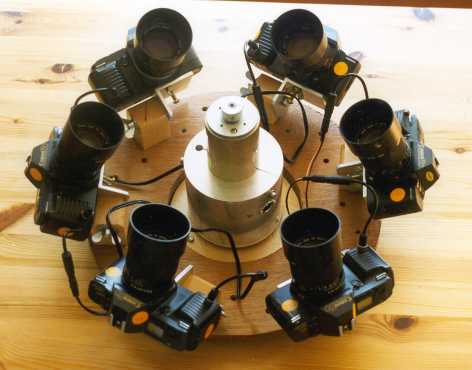 |
The Sino-Dutch Leonid Expedition '98 has urged the development of a new style of camera-array which is especially suited to be used on expeditions.
These expeditions distinguish from standard local observing sessions by travelling over (sometimes long) distances together with technical equipment such as a power generator, cables, camera-array's, image intensifier system, laptop.
This kind of expeditions are well organised long in advance and every aspect has been taken into consideration.
During so called "crash" observing campaigns observers move to a location with clear skies taking with them all of most of their equipment. This kind of expedition is not at all organised e.g. 24 hours ago we didn't know were observations would take place.
These two kinds of expeditions both calls for "all_in_one", lightweight, small and ruggedized equipment especially designed for mobility.
The camera-array designed and build by Robert Haas "The Canon T70-50 mm project" is a very good example of such camera-array.
This design however focussed primarily on the easy of setting-up the camera-array and the ruggedized flightcase which is commonly used by technicians of e.g. broadcasting stations as they travel all the world over by plane and by car. This design is an example of the "all_in_one" principle: everything is build-in and one only needs a poweroutlet to get the system running.
Dr. Peter Jenniskens from NASA-Ames pointed out the importance of high accuracy photographical observations in order to compute well defined orbital elements of the fast moving Leonid particles.
This set us to think how to achive this target. Let us list some of the items which influence the accuracy and how to improve these.
- Choice of camera's and lenses
- Sector formfactor
- Mounting camera's and sector
- Heating camera's and lenses
We normally use SLR Camera's equipped with standard 1.8/50 mm lenses. To achieve
sharp images the diafragms of the lenses are stopped down by 1, so a 1.8 lens is set to 2.8.
By using 1.8/85 mm lenses we improve the liniear accuracy by a factor 1.7 and the calculated helocentric
velocity of the meteor by the square which is about 2.9.
Most sektors now in use have 2, 3 or 4 blades rotating at 12.5 rounds per second resulting
in 25, 37,5 or 50 breaks per second. By using 6 or 8 blades this results in 75 or 100 breaks per second so
measuring errors in the position of breaks can be averages which decreases the overall error in the orbital elements.
Increasing the rotational speed is an option but has its disadvantaged. The vibrations will increase quadratic which
is a threat to the safety of the camera-array and also to the people operation the equipment.
Mounting the sektormotor separately from the camera's will eliminate
the vibrations of the camera's.
Nowadays we do not mount the cameraplatforms on tripods as these are the main cause for
increased vibrations. Another disadvantage is the time involved to mount the platform on
the tripod. This is why we put the cameraplatform directly on a flat surface such as a
concrete floor.
Heating of lenses and camera's is carried out by means of resistors of
5 to 20 watts each. These resistors are mounted beneath the camerahouse. Heating the
lens prevents forming of dew on the frontlens. Heating the entire camera prevents the
film from bowling and keeping the transportation system functioning also with temperatures
well below zero.
But heated air causes turbulenses and while these are magnified using a 85 mm lens are
the cause for (slightly) unsharp images. This is why the camera's and lenses of the 85 mm
project are not heated by the use of resistors.
Preventing dew on the frontlens should, in most cases, be avoided by use of a dewcap.
The camera's are kept dry by wrapping a scarf around the camera's. These two methods did
work out well at our expedition in China.
 |